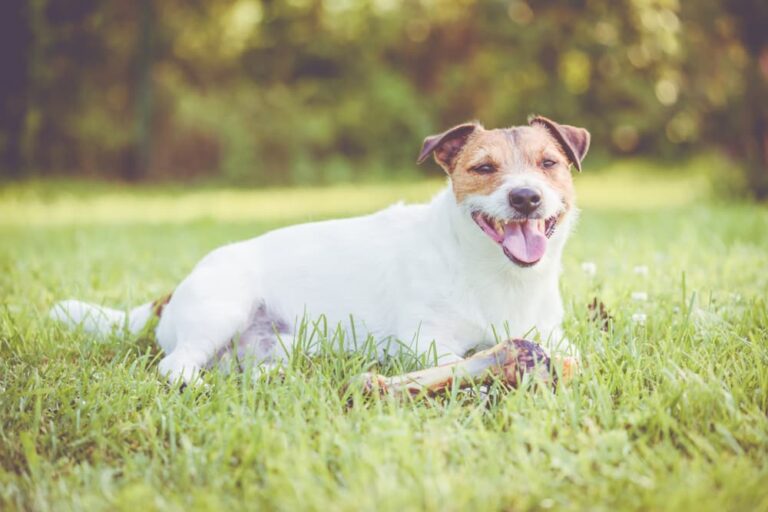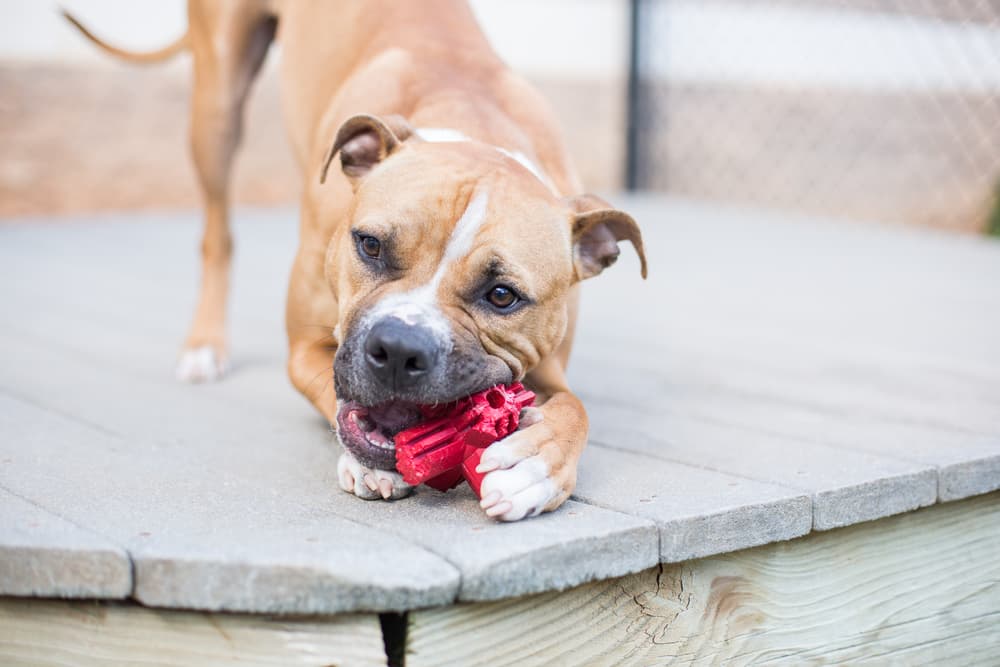Can Dogs Eat Bones?

There’s an ongoing and sometimes divisive debate within the veterinary community. At issue is a seemingly simple question: Are bones appropriate to feed dogs?
While some veterinarians tout the nutritional benefits of bones, many others warn of potential safety issues. Between 2010 and 2017, the U.S. Food & Drug Administration (FDA) received reports of 90 dogs who had become sick or injured after eating bone treats (processed bones sold as dog treats) (1). Symptoms varied widely—everything from choking, vomiting, and mouth cuts to gastrointestinal blockage, rectal bleeding, diarrhea, and even death.
Of course, it’s always best to talk to your veterinarian when deciding whether to feed your dog any type of bone or raw food diet. But to help you navigate the issue, we asked veterinarians on both sides of the debate for their insights about the benefits and risks of feeding your dog bones.
Are Bones Good For Dogs?

Veterinarians who support the practice of feeding your dog an occasional bone cite two primary benefits:
Nutritional Benefits of Bones for Dogs
Bones are a good source of calcium and phosphorus, both of which play a role in supporting the development of strong bones and muscles. However, a dog who’s fed a complete and balanced diet—formulated according to standards set by the Association of American Feed Control Officials (AAFCO)—doesn’t need additional minerals, says Dr. Lindsey E. Bullen, diplomate of the American College of Veterinary Nutrition and veterinary nutritionist at BluePearl Specialty + Emergency Pet Hospital in Raleigh-Durham, North Carolina. In fact, a surplus of these nutrients could cause other medical problems. “For example, excessive calcium can result in hypercalcemia and calcium oxalate urolithiasis/urinary stones,” Bullen explains.
While it may seem natural and beneficial to feed your pup meaty bones similar to the ones their ancestors may have eaten in the wild, keep in mind that dogs diverged from wolves tens of thousands of years ago… as did their dietary needs.
According to Bullen, “Just because wolves eat bones doesn’t mean our pets should.” Wolves, she says, eat bones because they have fewer options. “I would no more recommend feeding my kids like their ancient Neanderthal cousins than I would recommend my dog being fed like a wolf, even though she is a Shepherd.”
Dental Benefits of Bones for Dogs

Bones can promote dental health and satisfy a dog’s natural urge to chew, says Dr. Laurie S. Coger, an integrative and functional medicine veterinarian and founder of Healthy Dog Workshop and Healthy Dog Expo. According to Coger, “Thoughtfully chosen bones, appropriate for a dog’s size and chewing style, are great for dogs.”
In a study published in the Australian Veterinary Journal, of the eight Beagles evaluated, those who were fed raw bovine bones had a reduction in dental calculus of up to 87.8 percent (2). However, according to veterinarians, the flipside is that munching on bones can result in dental fractures, as well as other injuries such as gum lacerations and choking. And because dogs don’t easily digest bones, ingesting them can result in blockage of the small intestine.
Though the study’s researchers found no evidence of tooth fractures, gastrointestinal obstructions, or pieces of bone stuck between the Beagles’ teeth, they reported that the bone was diminished to smaller pieces, and in some cases completely eaten.
Do crushed and ground bones make a difference?
Crushed and ground bones can reduce the risk of obstruction and cuts, provided that the final components are ground so small they won’t block the gastrointestinal tract, says Bullen. However, there’s a difference between crushed or ground bones and those that are broken down into small chunks. “If the bones are broken down to smaller pieces, there can be a risk of GI obstruction and perforation, which is a surgical and life-threatening emergency,” Bullen adds.
Can Dogs Eat Bones?

A number of veterinarians agree the risks of eating bones outweigh the benefits for dogs.
“I am sure there are millions of dogs who have chewed on a bone and lived to tell the tale,” says Colorado-based veterinarian Dr. Sarah J. Wooten. “But, as a veterinarian, I always get to treat the dogs that didn’t have such a safe and enjoyable time. And I would like to save each and every one of those dogs the pain and suffering associated with bone chewing gone wrong.”
As a general rule, holistic veterinarian and founder of Pet Synergy Dr. Anna Maria Wolf recommends large-sized marrow bones (also known as leg bones) because they’re less likely to splinter and break off into smaller pieces.
There are some exceptions to this rule, however. Here’s a breakdown of some of the most popular types of bones.
Can Dogs Eat Chicken Bones?

Chicken marrow bones are small, which increases the risk of blockage. Additionally, “cooked chicken bones can splinter and cause damage to the digestive tract and should never be fed,” says Wolf. “Feeding raw chicken bones also presents some risks.” Therefore, chicken bones should never be fed to dogs. If your dog does somehow ingest chicken bones, or any other type of bones, stay vigilant for any signs or symptoms that could indicate a potential problem.
Can Dogs Eat Rib Bones?
Rib bones are larger than chicken bones, but Wolf generally doesn’t recommend them for dogs. “They are more likely to splinter and can be swallowed and cause choking,” she warns. They also contain too much saturated fat for dogs, putting them at risk of pancreatitis. Rib bones are also one of the offenders listed in the FDA’s report on injuries and illnesses suffered by dogs who ate certain bone treats.
Can Dogs Eat Ham Bones?

Wolf doesn’t recommend ham bones because they tend to splinter. Ham bones are also considered too high in fat for a dog’s nutritional needs. They’re also listed in the FDA’s report as a category of bone treats that caused injury or illness to dogs.
Can Dogs Eat Turkey Bones?
Turkey marrow bones are larger than chicken bones. However, that doesn’t necessarily make them a safer choice. “Many people feed them as part of a raw food diet,” says Wolf. “But it is important to be aware that they can cause choking and obstruction. It’s also crucial (as with chicken or any bone) to avoid contamination and be aware of the risks,” she adds.
Can Dogs Eat Steak Bones?

The advantage of raw steak bones is that they’re harder than most other types of animal bones, so are less likely to splinter than, say, a chicken or turkey marrow bone. However, “I don’t recommend these due to the size and the risk of choking and obstruction,” says Wolf.
Another reason not to let dogs eat steak bones, says Wooten, is the risk of pancreatic inflammation due to the high fat content.
Can Dogs Eat Lamb Bones?
Provided they’re large leg bones, they’re ok to use, says Wolf. Just “make sure they are the right size—larger than the muzzle—for your dog.”
Can Dogs Eat Pork Chop Bones?
Veterinarians recommend against feeding dogs pork bones because of the increased risk of injury. “I generally avoid pork bones, as they do seem to break off and pose an obstruction risk,” says Coger. Pork femur bones are on the FDA’s list of bone treats that caused injury or illness to dogs.
Bones for Dogs: Raw vs. Cooked

Raw and cooked bones present different types of hazards.
Can Dogs Eat Raw Bones?
A primary risk associated with raw bones (or any raw food diet for dogs) is the potential for bacterial contamination. The American Veterinary Medical Association discourages feeding cats and dogs any meat that has not been adequately cooked to destroy harmful pathogens (3).
Raw bones have a significantly increased risk of harboring bacteria and parasites, including E. coli, Salmonella, Listeria, and Campylobacter, says Bullen.
“Bacterial contamination can cause vomiting and diarrhea in dogs, and it can be dangerous for humans with reduced immune systems,” adds Wooten.
Can Dogs Eat Cooked Bones?
Cooking does kill potentially harmful bacteria, so in that regard, they’re preferable to raw bones, says Bullen. “However, cooking can cause bones to splinter or break more easily because it starts to soften and break down the bone. This increases the risk of gastrointestinal obstruction and/or perforation caused by splintered bone fragments.”
Bone Safety Tips for Dog Parents

If you’d like to feed your dog an occasional bone, here are some veterinarian-approved guidelines to help you do so safely.
Start With Your Veterinarian
Wolf, who feeds bones to her own dogs, admits it’s a tough decision to make for pet parents, which is why she strongly recommends working with a veterinarian.
Your veterinarian understands your dog’s medical history and can best determine if bones are conducive to their good health. “Dogs with immune system issues, for example, or who are on immunosuppressive medications should not eat bones. Or for dogs with other health conditions such as IBD (inflammatory bowel disease), bones would not be recommended,” explains Wolf.
Work with a Veterinary Nutritionist

Consult a veterinary professional with extensive training in pet nutrition. “If a person wants to feed raw bones, I recommend working with a board-certified veterinary nutritionist to formulate the diet,” says Wooten.
Always Supervise Chew Time
Animals should always be supervised when chewing any object, recommends Bullen. “If the bone (or toy, or whatever it may be) fractures, the pet should not be allowed to consume it, and it should be thrown away.”
Be aware that dogs can be possessive of bones, adds Wolf. “Some dogs are very obsessive and will grind their teeth down by chewing too much and chewing off chunks of bone. So for those dogs, I would probably avoid bones altogether or only provide them for short times with supervision.”
Know When to ‘Size Up’

Generally, it’s a good idea to “size up” any chew item you offer your pet, offers Bullen. “A dog should not be able to get their jaw around it, but rather should have to gnaw on it from the side,” she explains.
Keep in mind that even larger dogs can become injured from eating bones improperly, says Wolf. “So consult with your veterinarian to determine if they are able to eat bones.”
Prepare it Properly
Avoid serving cooked bones, as they can easily splinter and break apart. Coger says you should also never feed your dog frozen bones. “It makes the bone very hard and poses a tooth breaking risk.”
Bones can be crushed or ground with meat, provided they’re ground up small and don’t have any sharp pieces, says Wolf. “This is safer as far as choking and chewing damage, but also loses some of the advantages, such as behavioral benefits and teeth cleaning.”
Bone Alternatives for Dogs

Other products—like antlers and pig ears—exist on the market, but Bullen recommends avoiding these alternative animal chews. “They can potentially be contaminated and tend to have many extra, empty calories, which causes obesity and results in an unbalanced diet.”
A durable chew toy is a great alternative to animal bones, says Bullen. “Speak with your veterinary dentist and/or your veterinarian, as they likely have safe chew toy recommendations.”
Though it won’t satisfy your dog’s need to chew, bone broth is another healthy option to consider, and “They might be a safer option where bones could be a concern,” says Wolf. Potential benefits of bone broth for dogs include improved joint health, immune support, a good source of essential minerals, and support for digestive health.
As always, ask your veterinarian if any of these options are appropriate for your dog. There’s no doubt that your pup deserves a treat from time to time. Knowing all the facts and consulting with a trusted pro ensures you can make the best decision for your pet.









